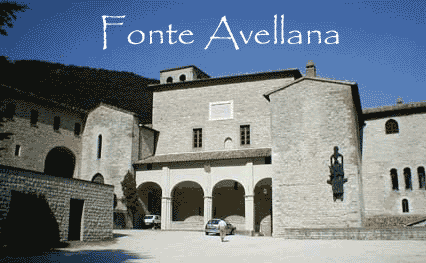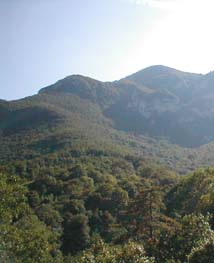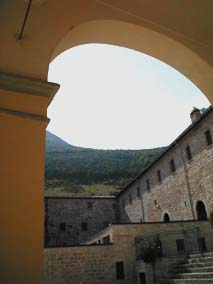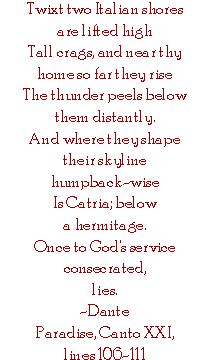

![]()
![]() A
monk's life is dedicated to embracing religion, nature, and simplicity,
and the inspirational beauty of the Monastery of Fonte Avellana, just
over twenty kilometers from Cagli, reveals that conviction in its most
unaltered form.
A
monk's life is dedicated to embracing religion, nature, and simplicity,
and the inspirational beauty of the Monastery of Fonte Avellana, just
over twenty kilometers from Cagli, reveals that conviction in its most
unaltered form.
2275 feet above sea level
on Mount Catria, this medieval hermitage is naturally isolated by the
sloping hills of the Apennines that surround it. Although the hermitage
was founded in 980, Peter Damian, who was later canonized, established
the monastery in 1035. He transformed Fonte Avellana into the center of
spiritual worship in the regions of Le Marche and Umbria.
Dante, the fourteenth
century writer, stayed at Fonte Avellana while exiled from Florence. He
referenced it in the paradise section of his Divine Comedy and
a stone plaque on the front wall of the monastery is engraved with his
words.
Presently, only eleven monks still reside there; they are part of the Camaldolese order of St. Benedict. Five main rooms of their hermitage are open for public viewing from April to September.

A shaded path leads to one entrance at the monks' quarters



The Scriptorium is just off the main entrance. This is where
the monks used to prepare their manuscripts on dried sheepskin. Today,
modern desks fill the gothic styled stone room.
The monks gather for reflection before prayer in the cloister,
an open air courtyard, the center of the hermitage. This cloister offers
a pathway to the chapter room, which was once used as a bakery and is
today used as a meeting room. It features ancient frescos and a picture
of the Madonna given by Pope John Paul II; he celebrated a 1000 year anniversary
mass at Fonte Avellana in 1985.
Beyond the chapter room is the crypt, the oldest room in the
monastery. A constant thirteen degrees Celsius, the room has stone walls
and small windows and offers a cool place for worship. Originally, the
crypt was the primary chapel, but as the monastery expanded, another chapel
was built above it.
The chapel is located at the top of a narrow stairway. It
is a simple, small basilica with three rows of pews on each side, an altar,
and a large crucifix. On either side of the church are shrines to Saint
Victoria and Saint Albertino. The shrine to Saint Albertino contains his
actual body preserved in wax.
This ancient hermitage is now a modern day tourist destination because of its rich history and natural beauty. The local bike shop will organize small groups for a guided ride and lunch up the steep roads to Fonte Avellana. This gem of the region is one of Cagli's most famous hidden pieces of history.

The simple entrance into the small basilica
Photography: Alissa Fetner
Design Production and Graphic Design: Emily DePietro